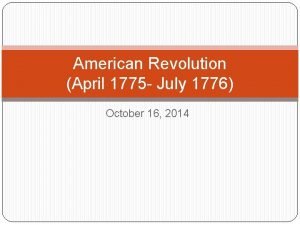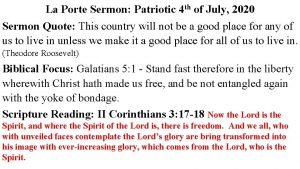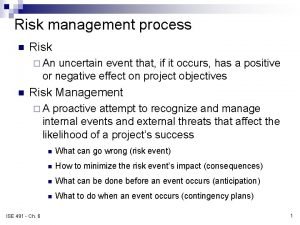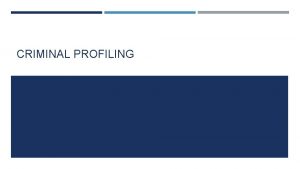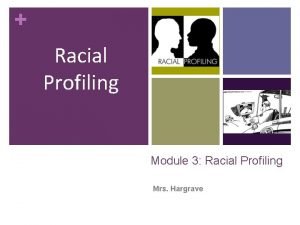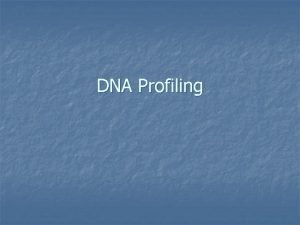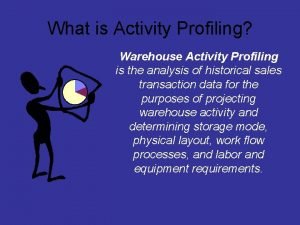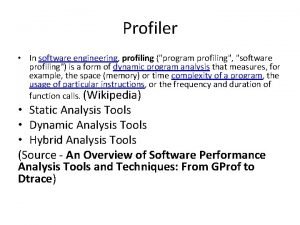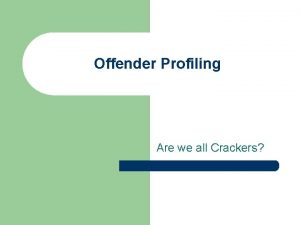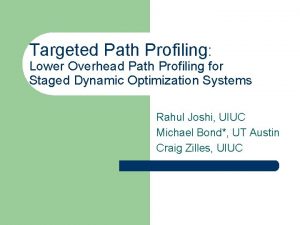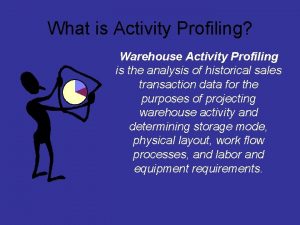Profiling Module 4 Profiling as of 10 July






































- Slides: 38

Profiling Module 4: Profiling as of 10 July 2015

Agenda § Evaluation Reporting System − Responsibilities of the Rating Chain − Role of the Rating Chain & Keys to Success − Developing a Rating Philosophy § Rater Overall Performance − − Rater Comments Rater Tendency Label Rater Tendency Report § Senior Rater Overall Potential − − − − Senior Rater Narrative Senior Rater Consistency Immature Profile / Small Population Senior Rater Profile Calculation Senior Rater Profile Box Check Warning Senior Rater Profile Labeling Rules Managed Profile Technique Unclassified 2

Agenda (cont. ) § Evaluation Entry System (EES) Tools − − − − Rater Tendency / Senior Rater Profile Link Rater Tendency / Senior Rater Profile ERS Link to Senior Rater Profile (DASH 2) Senior Rater Profile Dashboard Senior Rater (DASH 2) Senior Rater Profile Management Tool How to Assign / Manage Delegates Unclassified 3

Evaluation Reporting System § Primary function of the evaluation report is to provide key information to HQDA for use in making critical personnel management decisions. § The NCOER is an assessment tool. − − Stand-alone evaluation for a specific rating period Rater comments focused on specific, quantifiable performance Senior rater narrative focused on potential Senior rater profile for senior raters of SSG-CSM/SGM; limited to 24% for the “MOST QUALIFIED” selection § Promotion selection system is based on current and future force structure requirements. − Cannot predict selection board results – DA Centralized Selection Boards use the “Whole File Concept” − Use the top box to identify your best NCOs § Commander is the overall caretaker of all personnel systems. § Counseling is key. Unclassified 4

Responsibilities of the Rating Chains: Rating Roles: § Are established by commanders and maintained by rating officials § Tie rated NCO’s performance to a specific senior / subordinate relationship § Correspond as nearly as practicable to chain of command supervision § Are established by name, given effective dates, published, and distributed to all concerned § List the rated NCO and all rating officials § RATER − Day-to-day performance & counseling – Met standards? Yes / No – Narrow, more specific § SENIOR RATER − – – – Potential & mentorship Capstone evaluation, spread of quality Adherence to policy & intent Broader, more general § SUPPLEMENTARY REVIEWER − Required in certain situations – Performed by uniformed Armydesignated rating official Critical Point: Separating rater and senior rater & keeping supervisors at lowest levels have been keys to success Unclassified 5

Role of the Rating Chain & Keys to Success § Senior rater is the “owner” of the evaluation and is responsible for timely completion § Mentor/Develop your subordinates – Support Form – tool available to aid in defining/guiding goals and objectives throughout rating period, provides feedback to rated individual – not a lot of space but should be catalyst of conversation § Understand how our Evaluation System works – – Fairly and accurately assess subordinates – participate in counseling Senior rater narrative is key: exclusive vs. strong narrative to describe subordinate Quantify potential…identify your best Be careful… What you don’t say is just as damaging as what you do say § Verify/Certify your subordinates on how to assess – ask them to bring their counselings and assessments with them to their counseling § Understand how to manage your rater & senior rater profile – develop your rating philosophy § Anticipate and project “next” evaluation − Current thru date on file plus 12 months or known changes of rater − Complete the record dates for those being considered by a board § Monitor when reports are required, that they’re submitted on time, and unit rating schemes are current and accurate (Leader responsibility) – Use Evaluation Entry System (EES) to prepare and submit, track with reporting tools within – Be aware of sequencing Unclassified 6

Developing a Rating Philosophy § Mission – know your population and identify your best § Counseling – ensure counseling is accomplished; those who can, will improve § Decide how to assess, particularly “FAR EXCEEDED STANDARD” based on performance and “MOST QUALIFIED” based on potential § Write well – quantify and qualify in narrative; correspond comments with box check as the system allows; use the narrative to paint the picture § Plan – think series of reports (number of times you will rate an NCO), projected departures, and future boards Unclassified 7

Performance Measures Organizational- and Strategic-level (SSG through CSM/SGM) Direct-level (SGT) FAR EXCEEDED STANDARD MET STANDARD DID NOT MEET STANDARD Rated NCO performs extraordinarily above the required Army standards and organizational goals of leader competencies and attributes; leadership enables Soldiers and unit to far surpass required organizational and Army standards; demonstrated performance epitomizes excellence in all aspects; this NCO and his/her Soldiers consistently take disciplined initiative in applying leader competencies and attributes; results have an immediate impact and enduring effect on the mission, their Soldiers, the unit, and the Army; demonstrated by the best of the upper third of NCOs of the same grade. Rated NCO performs above the required Army standards and organizational goals of leader competencies and attributes; this NCO and his/her Soldiers often take disciplined initiative in applying leader competencies and attributes; results have an immediate impact on the mission, their Soldiers, the unit, and the Army; this level of performance is not common, typically demonstrated by the upper third of NCOs of the same grade. Rated NCO successfully achieves and maintains the required Army standards and organizational goals of leader competencies and attributes; effectively meets and enforces the standard for the unit and those in his/her charge; succeeds by taking appropriate initiative in applying the leader competencies and attributes; results have a positive impact on the mission, their Soldiers, the unit, and the Army; this level of performance is considered normal and typically demonstrated by a majority of NCOs of the same grade. Rated NCO fails to meet or maintain the required Army standards and organizational goals of leader competencies and attributes; does not enforce or meet the standard for the unit or those in his/her charge; exhibits/displays minimal or no effort; actions often have a negative effect on the mission, their Soldiers, the unit, and the Army. Unclassified 8

Rater Overall Performance § “FAR EXCEEDED STANDARD” / “EXCEEDED STANDARD” – identify the upper third of NCOs for each rank with further stratification of the upper third by use of the “FAR EXCEEDED STANDARD” box check § “MET STANDARD” – identify NCOs who successfully achieved and maintained required Army and organizational standards § “DID NOT MEET STANDARD” – identify NCOs who did not meet required Army and organizational standards Unclassified 9

Rater Comments Focus on specific, quantifiable performance – • Identify what a NCO did and how well they performed • Quantify and qualify performance § The rater is the first individual to assess and write comments. § Comments should explain what the rated NCO did and how well he/she performed. § A laundry list of superlatives is not helpful to selection boards – more is not necessarily better. § Selection board members use the rater’s comments in their file deliberations when they are looking for in-depth information on the rated NCO’s performance. § In the event the senior rater does not meet the minimum time requirements, then the rater’s comments are the sole basis for assessing the rated NCO. § Rater Overall Performance section − Must include comment(s) concerning rated NCO’s overall performance Unclassified 10

Rater Tendency (applies to SSG-CSM/SGM) § Tracks the rating history for each rater of NCOs (SSG-CSM/SGM) for all components (Regular Army, Reserve, Guard) § Emphasizes the following: − Importance of the rater’s role and responsibility to provide credible information to HQDA − Importance of a rater’s sequencing of NCOER submissions to avoid inflation § Provides information to HQDA Selection Boards and Army Leadership on the rater’s rating tendency § Continues without interruption as the rater moves from unit to unit, position to position, regardless of promotion § Rater Tendency restart Unclassified 11

Rater Tendency Label (applies to SSG-CSM/SGM) 2 3 6 1 Total Ratings: 12 Note: This is the rater’s “capstone” assessment of performance and opportunity to “stratify / quantify. ” § Key information includes the following: − Rater tendency (i. e. , rating history) – the value below each box equals the overall history of those ratings in this grade − Rater tendency label will be imprinted on the NCOER and viewable within the Evaluation Entry System (EES) by the rater’s rater and senior rater Unclassified 12

Rater Tendency Report (applies to SSG-CSM/SGM) Tracks the rating history of each rater for NCOs of all components by rank (SSG through CSM / SGM). Raters do not maintain a rater tendency on NCOs in the rank of SGT and below. Unclassified 13

Senior Rater Overall Potential Limited to 24% for SSG – CSM/SGM § “MOST QUALIFIED” – identify NCOs with strong potential for promotion in the secondary zone; ahead of peers (Note: Senior rater cannot have more than 24% of total ratings in a grade to retain the MOST QUALIFIED label. ) § “HIGHLY QUALIFIED” – identify NCOs with strong potential for promotion with peers § “QUALIFIED” – identify NCOs who demonstrate potential to be successful at the next level; promote if able § “NOT QUALIFIED” – identify NCOs who do not demonstrate potential for promotion; recommend separation Unclassified 14

Senior Rater Narrative Should quantify and qualify the passion (or lack thereof) that the senior rater has for the rated NCO’s potential § Selection boards should not have to guess – Send a clear message § What is not said can have the same impact as what is said § Be careful with your narrative – don’t say the same thing for all your NCOs § Avoid using the same verbiage year-to-year for the same NCO § Be consistent … words match the box check § Cannot mention box check or board language in the narrative (i. e. , “MOST QUALIFIED NCO”, “ 6+ NCO”, “If my profile allowed, I would rate this NCO higher. ”); these are considered prohibited narrative comments Unclassified 15

Senior Rater Consistency § Senior raters need to amplify their potential box checks by using the narrative to clearly send the appropriate message to selection boards. The following classification of types of narratives may serve as a guide and assist in sending a clear message: − Exclusive narratives – those which clearly describe superior performance/potential above that of the vast majority; associated with early promotion and are restrictive in nature (e. g. , top 1%, 3%, 5%, etc. of all NCOs, the best among a select grade or group, promote in the secondary zone) − Strong narratives – those which describe significant performance accomplishments and enthusiastically recommend promotion, assignment to key duty positions linked to upward mobility and appropriate military schooling (e. g. , among the best, easily in the top third of the NCO Corps, definitely promote this NCO, secondary zone potential, one of my best NCOs) − Enumeration – a technique used to rank order NCOs in a particular grade based on demonstrated performance and/or potential (e. g. , #1 of 6) Unclassified 16

Immature Profile / Small Population HQDA COMPARISON OF THE SENIOR RATER’S PROFILE AT THE TIME THIS REPORT PROCESSED HIGHLY QUALIFIED Small Population (3 or less) RNCO: SMITH, BOB SR: DODD, JANE DATE: 2017 -05 -01 TOTAL RATINGS: 3 RATINGS THIS NCO: 1 Immature Profile (5 or less) § Future Guidance to DA Centralized Selection Boards for the New NCOER − Check DA Label: “Total Ratings” (5 or less = immature profile) − Check Part V block a – same grade in population (3 or less = small population) − Expect “HIGHLY QUALIFIED” assessment if immature profile and/or small population exists − Focus on Senior Rater’s narrative Unclassified 17

Senior Rater Profile Calculation Type of Report THRU Date Box Check “Most Qualified” Annual 20160201 X Co. R 20160413 Co. R 20160623 Annual 20160824 Annual 20161128 Co. R 20170120 Annual 20170131 Ext Annual 20170530 Annual 20171119 Ext Annual 20180117 Box Check “Highly Qualified” Box Check “Not Qualified” Profile MQ Profile HQ Profile NQ Total Date of Receipt SR Profile 1 0 0 0 1 20160212 100% 1 1 0 0 2 20160417 50% 1 1 1 0 3 20160701 33. 3% X 1 2 1 0 4 20160825 25% X 1 3 1 0 5 20161130 20% 1 3 2 0 6 20170205 16. 7% X 1 4 2 0 7 20170131 14. 3% X 1 5 2 0 8 20170602 12. 5% 2 5 2 0 9 20171123 22. 2% 2 6 2 0 10 20180118 20. 0% X X X Based on the profile limitation of 24%, a senior rater can render a “MOST QUALIFIED” assessment for a particular grade (SSG through CSM/SGM) as follows: • Any one of the first four reports • The second “MOST QUALIFIED” assessment no earlier than the ninth report (2 / 9 = 22. 2%) • The third “MOST QUALIFIED” assessment no earlier than the thirteenth report (3 / 13 = 23. 1%) • The fourth “MOST QUALIFIED” assessment no earlier than the seventeenth report (4 / 17 = 23. 5%) Unclassified 18

Senior Rater Profile Box Check Warning As each NCOER is rendered, the Evaluation Entry System (EES) will automatically calculate the senior rater profile. If the profile does not support a “MOST QUALIFIED” selection, then EES will display the above warning notification and the “MOST QUALIFIED” option will be grayed out. Unclassified 19

Senior Rater Profile Labeling Rules § Rule #1: If the Senior Rater checks the “HIGHLY QUALIFIED, ” “QUALIFIED, ” or “NOT QUALIFIED” box, then the report is always labeled as indicated on the form. − The sum of “HIGHLY QUALIFIED, ” “QUALIFIED, ” and “NOT QUALIFIED” box checks must always be at least 76% of total ratings rendered. § Rule #2: If the senior rater checks the “MOST QUALIFIED” box and the senior rater’s use of “MOST QUALIFIED” is no more than 24% of the total ratings, then the report is labeled “MOST QUALIFIED. ” − An entry of “MOST QUALIFIED” will only be accepted if the mathematical result of the entry is no more than 24% of the total number of reports rendered in that grade. § Rule #3: “MISFIRE” – If the senior rater completes a pdf-fillable NCOER and checks the “MOST QUALIFIED” box and the senior rater profile is greater than 24%, then the report is automatically downgraded and labeled “HIGHLY QUALIFIED” upon receipt at HQDA and the senior rater is charged with a “MOST QUALIFIED. ” − EES will not allow senior rater misfires. Unclassified 20

Managed Profile Technique – Rule 1 (the comparison of box check to SR Profile) HQDA COMPARISON OF THE SENIOR RATER’S PROFILE AT THE TIME THIS REPORT PROCESSED HIGHLY QUALIFIED RNCO: SMITH, BOB SR: DODD, JANE DATE: 2017 -02 -01 TOTAL RATINGS: 20 RATINGS THIS NCO: 2 HQDA COMPARISON OF THE SENIOR RATER’S PROFILE AT THE TIME THIS REPORT PROCESSED QUALIFIED Regardless of profile RNCO: SMITH, BOB SR: DODD, JANE DATE: 2017 -02 -01 TOTAL RATINGS: 20 RATINGS THIS NCO: 2 HQDA COMPARISON OF THE SENIOR RATER’S PROFILE AT THE TIME THIS REPORT PROCESSED NOT QUALIFIED RNCO: SMITH, BOB SR: DODD, JANE DATE: 2017 -02 -01 TOTAL RATINGS: 20 RATINGS THIS NCO: 2 Unclassified 21

Managed Profile Technique – Rule 2 (the comparison of box check to SR Profile) MOST QUALIFIED HIGHLY QUALIFIED NOT QUALIFIED – – 1 5 2 0 TOTAL RATINGS = 8 MOST QUALIFIED HIGHLY QUALIFIED NOT QUALIFIED – – 2 5 2 0 TOTAL RATINGS = 9 Profile is 22. 2% (2 of 9). HQDA COMPARISON OF THE SENIOR RATER’S PROFILE AT THE TIME THIS REPORT PROCESSED MOST QUALIFIED RNCO: SMITH, BOB SR: DODD, JANE DATE: 2017 -02 -01 TOTAL RATINGS: 9 RATINGS THIS NCO: 2 Top block check labeled “MOST QUALIFIED” when profile is not more than 24% in top block. Unclassified 22

Managed Profile Technique – Rule 3 (the comparison of box check to SR Profile) MOST QUALIFIED HIGHLY QUALIFIED NOT QUALIFIED TOTAL RATINGS – – 2 5 2 0 MOST QUALIFIED HIGHLY QUALIFIED NOT QUALIFIED = 9 TOTAL RATINGS – – 3 5 2 0 = 10 MISFIRE – Profile is 30% (3 of 10). HQDA COMPARISON OF THE SENIOR RATER’S PROFILE AT THE TIME THIS REPORT PROCESSED HIGHLY QUALIFIED RNCO: SMITH, BOB SR: DODD, JANE DATE: 2017 -02 -01 TOTAL RATINGS: 10 RATINGS THIS NCO: 2 “MISFIRE” – Top block check labeled “HIGHLY QUALIFIED” when profile is greater than 24% in top block. Unclassified 23

Evaluation Entry System (EES) Tools https: //evaluations. hrc. army. mil/ Unclassified 24

Rater Tendency / Senior Rater Profile Link Unclassified 25

Rater Tendency / Rater and Senior Rater Profiles Only applies to Officers Unclassified 26

ERS Link to Senior Rater Profile (DASH 2) Unclassified 27

Senior Rater Profile Dashboard Unclassified 28

Senior Rater Profile Management Tool NAME Position # of Projected Subsequent Next Board/Date - NCOERs STATUS: Support Form Rating - How I NCOER to DA NCOER - Will Next selection previously Projected NCOER received, draft initiated, would rate this (90 days) - Date the officer Projected board the NCO received in (Date of next signed by all appropriate NCO if I rated report needs to receive more Type (Type Date of would be eligible Projected current Last NCOER / NCOER) personnel, submitted to all NCOs in this be at DA (Board reports from of report - Rank position Type / Rating for (Use chart Departure grade today reports need to you after the DA, received by DA, use codes) profile (include submitted to Soldier's (24% or less in get to DA per projected previous management MQ / adjust as board message). NCOER, if so, Record SR's board dates). events dictate) how many? OERS) From Thru Alpha, John A Platoon Sergeant 0 6 -Sep-15 5 -Sep-16 AN HQ 4 -Dec-16 1 1 -Jan-11 15 -Apr-17 5 -Feb-17 Bravo, Joe B Platoon Sergeant 0 11 -Sep-15 10 -Sep-16 AN HQ 9 -Dec-16 1 1 -Dec-11 15 -Apr-17 4 -Mar-17 Charlie, Jack C Platoon Sergeant 0 16 -Jul-15 31 -Jan-17 CR Q 30 -Apr-17 1 1 -Sep-14 16 -Jul-18 Alpha, John A Platoon Sergeant 1 6 -Sep-16 31 -Jan-17 CR HQ 30 -Apr-17 No 1 -Oct-14 15 -Apr-17 5 -Feb-17 Bravo, Joe B Platoon Sergeant 1 11 -Sep-16 31 -Jan-17 CR MQ 30 -Apr-17 No 1 -Mar-15 15 -Apr-17 4 -Mar-17 Charlie, Jack C Platoon Sergeant 1 1 -Feb-17 31 -Jan-18 AN NQ 1 -May-18 1 1 -Sep-14 16 -Jul-18 Delta, Bob D Platoon Sergeant 0 AN HQ 14 -May-18 No 1 -Nov-15 15 -Feb-19 Echo, Todd E Platoon Sergeant 0 AN HQ 19 -May-18 No 1 -Sep-15 20 -Feb-19 15 -Feb-17 14 -Feb-18 20 -Feb-17 19 -Feb-18 Senior Rater Profile Most Qualified Highly Qualified 1 5 % Top Block Qualified Not Qualified TOTAL 1 1 8 13% Note: Promotable NCOs serving in positions authorized the promotable grade will be profiled at the promotable grade if listed as (P) on the NCOER. Ratings NCOER Types MQ - Most Qualified (limited to 24%) AN = Annual PCS = PCS HQ - Highly Qualified CR = Change of Rater RFC = RFC Relief for Cause Q - Qualified CD = Change of Duty SRO = SR Option NQ - Not Qualified CTR = Complete the Record Unclassified 29

How to Assign / Manage Delegates Unclassified 30

How to Assign / Manage Delegates (cont. ) Unclassified 31

How to Assign / Manage Delegates (cont. ) Unclassified 32

How to Assign / Manage Delegates (cont. ) Unclassified 33

How to Assign / Manage Delegates (cont. ) Unclassified 34

Enlisted Advisor Comments Unclassified 35

Summary § Evaluation Reporting System − Responsibilities of the Rating Chain − Role of the Rating Chain & Keys to Success − Developing a Rating Philosophy § Rater Overall Performance − − Rater Comments Rater Tendency Label Rater Tendency Report § Senior Rater Overall Potential − − − − Senior Rater Narrative Senior Rater Consistency Immature Profile / Small Population Senior Rater Profile Calculation Senior Rater Profile Box Check Warning Senior Rater Profile Labeling Rules Managed Profile Technique Unclassified 36

Summary (cont. ) § Evaluation Entry System (EES) Tools − − − − Rater Tendency / Senior Rater Profile Link Rater Tendency / Senior Rater Profile ERS Link to Senior Rater Profile (DASH 2) Senior Rater Profile Dashboard Senior Rater (DASH 2) Senior Rater Profile Management Tool How to Assign / Manage Delegates Unclassified 37

Questions Unclassified 38
 C device module module 1
C device module module 1 Sensory language definition
Sensory language definition 2001 july 15
2001 july 15 Monday 13th july
Monday 13th july Malaga in july
Malaga in july What is the significance of july 4 1776 brainpop
What is the significance of july 4 1776 brainpop July 16 1776
July 16 1776 July 2 1937 amelia earhart
July 2 1937 amelia earhart July 1-4 1863
July 1-4 1863 Ctdssmap payment schedule july 2021
Ctdssmap payment schedule july 2021 Gdje se rodio nikola tesla
Gdje se rodio nikola tesla Super saturday tribal bingo july 4
Super saturday tribal bingo july 4 2003 july 17
2003 july 17 On july 18 2001 a train carrying hazardous chemicals
On july 18 2001 a train carrying hazardous chemicals I am silver and exact i have no preconceptions
I am silver and exact i have no preconceptions Gcc july 2020
Gcc july 2020 June 22 to july 22
June 22 to july 22 July 1969
July 1969 April june july august
April june july august July 30 2009 nasa
July 30 2009 nasa Leaf yeast
Leaf yeast July 4 sermon
July 4 sermon The third floor bedroom harris burdick
The third floor bedroom harris burdick Miss cuba receives an invitation
Miss cuba receives an invitation Astronomy picture of the day 11 july 2001
Astronomy picture of the day 11 july 2001 July 12 1776
July 12 1776 6th july 1988
6th july 1988 July 14 1789
July 14 1789 Sources nso july frenchhowell neill technology...
Sources nso july frenchhowell neill technology... July 26 1953
July 26 1953 June too soon july stand by
June too soon july stand by Uninvited guests harris burdick
Uninvited guests harris burdick Poppies in july poem
Poppies in july poem Example of uncertain event
Example of uncertain event Performance profiling wheel
Performance profiling wheel Continuous profiling
Continuous profiling Compucentric
Compucentric Gather counselling
Gather counselling Bottom up profiling
Bottom up profiling






